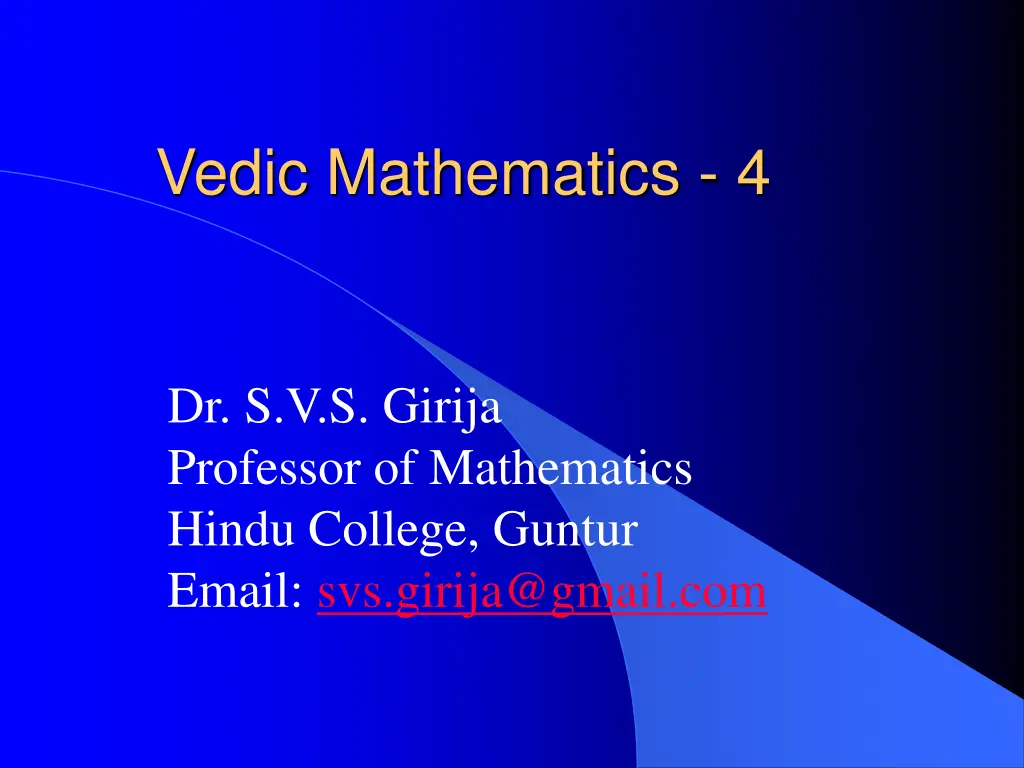
Master Vedic Mathematics Techniques for Division of Large Numbers
Explore Vedic mathematics techniques for efficiently dividing large numbers using Urdhva-triyagbhyam sutra and Dhvajanka sutra. Learn how to apply these methods step by step for accurate results.
Download Presentation

Please find below an Image/Link to download the presentation.
The content on the website is provided AS IS for your information and personal use only. It may not be sold, licensed, or shared on other websites without obtaining consent from the author. If you encounter any issues during the download, it is possible that the publisher has removed the file from their server.
You are allowed to download the files provided on this website for personal or commercial use, subject to the condition that they are used lawfully. All files are the property of their respective owners.
The content on the website is provided AS IS for your information and personal use only. It may not be sold, licensed, or shared on other websites without obtaining consent from the author.
E N D
Presentation Transcript
Vedic Mathematics - 4 Dr. S.V.S. Girija Professor of Mathematics Hindu College, Guntur Email: svs.girija@gmail.com
Outline of this class Using Urdhva-triyagbhyam sutra (vertically and crosswise) for division of large numbers. Division using Dhvajanka sutra (on top of the flag).
Sutra 1.Urdhva-Tiryak Sutra; 2 4 Quotient is 82 Remainder is 12 3 4 5: 6 2 :1 -------------- 8 2 : 12
Another Example 3: 7: Quotient is 534 Remainder is 0. 38 3 3 ------------------------- 5 3 9 8 :2 dividend row :1 remainder row 4 :0 quotient row
How does the method work There are three rows. The first row is the dividend. The second row is the remainder row. Third row is the remainder row. The divisor is placed according to the Dhvajanka Sutra.
What is the method? The entire division is to be by 7 (the leading digit). We allot one place at the right end of the dividend for the remainder portion of the answer. 1) We divide38 by 7 and we get 5 as the quotient and 3 as the remainder.
Crucial steps!! 2) We put 5 as the first quotient and place 3 on the top row. (note treat the next two digits as 39 - three from the remainder and 9 from the next digit in the dividend.) 3) From this, we deduct 3 * 5 (the last digit of the divisor and the quotient).39-15=24 is our next dividend.
Continue 4) When we divide 24 by 7 we get 3 as quotient and 3 as the remainder. As before, we place quotient 3 in the quotient row and remainder 3 in the remainder row. 5) Now the new dividend is 38-3*3=29 (3 is the remainder and 8 is the next digit in the dividend - so 38 and then subtract the product of 3 and 3 (the quotient and the last digit))
Contd 6) Dividing 29 by 7, we get 4 as the quotient and 1 as the remainder. Place 4 in the quotient row and 1 in the remainder row. 7) 12 is the next digit we need to consider. However, since 2 is the designated remainder in the first row, we will subtract as usual from 12 , the number 4*3 and we get the remainder is 0.
More Examples Divide 7632 by 94 Quotient: 81 Remainder 18 4 9 -------------------------- 8 76 4 3 :2 :2 1 :18
